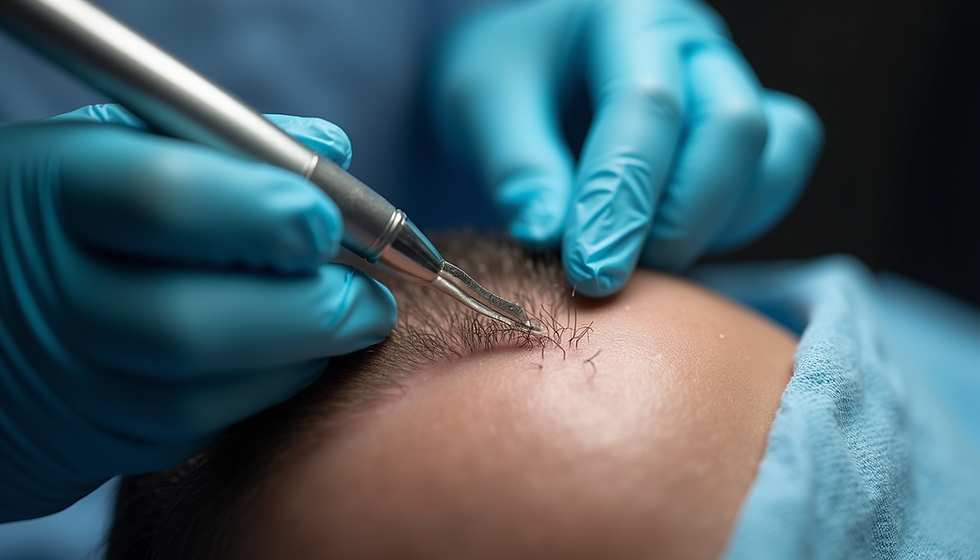DHI, FUE or FUT? Key Differences Explained
- Wayne Dharmalingam

- May 21
- 3 min read
Updated: Sep 22
When it comes to hair restoration, many patients find themselves overwhelmed by the choices available. Whether dealing with thinning hair or significant hair loss, understanding the differences between DHI, FUE, and FUT is essential for anyone considering a hair transplant. This article clarifies these popular hair transplant techniques, detailing their processes, recovery times, and which method may best address individual needs.
Understanding the Techniques
Direct Hair Implantation (DHI)
Direct Hair Implantation is an innovative technique known for its precision. In DHI, hair follicles are extracted using a specialized tool and implanted straight into the recipient area without making incisions. For example, this method can secure up to 2,500 grafts in one session without harming surrounding tissue.
The control over the angle and direction of hair placement results in a more natural look. In addition, DHI usually results in a quicker recovery time, often allowing patients to return to normal activities within just 3 to 5 days.
Follicular Unit Extraction (FUE)
Follicular Unit Extraction is another widely used technique that involves extracting individual follicular units using a micro-punch tool. Each unit is then inserted into the recipient area. Thanks to this method, doctors can harvest around 1,500 to 3,000 grafts in one sitting, which is beneficial for larger areas of hair loss.
FUE is celebrated for its minimally invasive nature, leading to less noticeable scars. Most patients enjoy a recovery period of about 5 to 7 days, making it a popular choice for those seeking quick return to daily life.
Follicular Unit Transplantation (FUT)
Follicular Unit Transplantation is a more traditional hair restoration procedure. In this method, a strip of tissue containing hair follicles is surgically removed from the donor area at the back of the scalp. Doctors can harvest from 2,000 to 4,000 grafts in one session, making FUT effective for those with significant hair loss.
However, it does require a surgical procedure, which leaves a linear scar. Consequently, recovery takes longer, typically 10 to 14 days, which may not suit everyone’s schedule.
Key Differences in Hair Transplant Methods
Scarring
A crucial consideration for patients is the type of scarring left by each technique.
DHI: Minimal scarring due to direct implantation.
FUE: Small dot-like scars, often unobtrusive even with short hair.
FUT: A linear scar that may be visible with short haircuts.
Choosing a technique that aligns with one's style is essential.
Recovery Time
Recovery varies among the methods:
DHI: Quickest recovery, typically 3 to 5 days for normal activities.
FUE: Takes about a week for recovery with potential mild discomfort.
FUT: Longer recovery, often requiring 10-14 days for adequate healing.
Patients should think about their personal schedules when selecting a technique.
Number of Grafts
The ability to harvest grafts efficiently can impact decisions:
DHI: Allows for around 1,000 to 2,500 grafts in one session, suited for smaller areas.
FUE: Can harvest a larger number, making it ideal for broader coverage.
FUT: Generally the most effective in harvesting a high number of grafts, often over 3,000, in a single sitting.
For those facing significant hair loss, the number of available grafts plays a crucial role.
Making the Right Choice
Determining whether DHI, FUE, or FUT is right for you largely depends on personal needs and preferences. Here are some factors to ponder:
Extent of Hair Loss: Patients with advanced hair loss may need a method that can secure a higher number of grafts.
Desired Level of Invasiveness: Those who prefer less invasive techniques might opt for DHI or FUE.
Scarring Preferences: Consider how noticeable scarring might affect your hairstyle choices.
Time for Recovery: If you have a busy schedule, DHI or FUE might be preferable.
Cost: DHI and FUE tend to be more affordable than FUT, but prices can vary based on the clinic.
Final Thoughts on Hair Transplant Techniques
In conclusion, the ideal hair transplant method depends on your specific needs and preferences. Each technique—DHI, FUE, and FUT—offers unique benefits and drawbacks that can significantly impact the results. By understanding the key differences among these methods, patients can make informed decisions leading to successful and natural-looking hair restoration. Always consult with a qualified hair transplant specialist to explore what option best fits your expectations and lifestyle.



_edited.png)



Comments